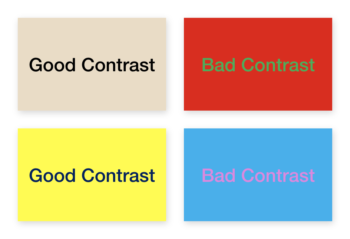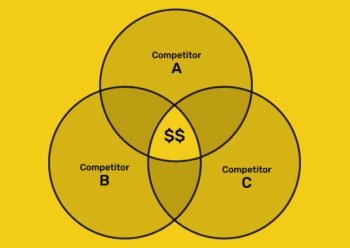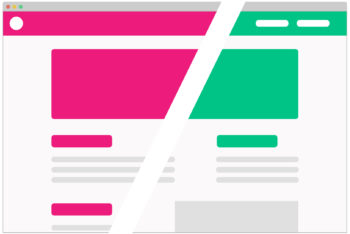When it comes to conducting user research for your app or website, there are two predominant methods: quantitative and qualitative. While one method isn’t necessarily better than the other, there are inherent differences that make them more suitable for achieving particular insights. One thing to remember is that both quant and qual research can give you invaluable insights, and are oftentimes dependent on one another. Incorporating user research into your business plan is crucial to addressing the substantiated wants and needs of your clientele. In this article, we’ll explain what makes these methods unique as well as how and when to effectively use them.

Using Quantitative and Qualitative Research for Business Websites
What is Quantitative Research?
Simply put, quantitative research (quant, for short) is that which collects and yields numerical data, while qualitative research (qual, for short) is that which collects and defines non-numerical data. For example, you would use quantitative research to determine the length of time the average user spends looking at a particular page on your website. Qualitative research would help you determine why the user went to that page by analyzing their opinions, motivations, and behaviors. The type of research you use at any given time is dependent on what your objectives are.

Let's take a deeper dive into quantitative research. There are three main types of questions that quant research helps to objectively answer. They are:
How many?
How often?
How much?
Analytics play a major role in collecting quant data. You can use web analytics to keep track of page visits, conversion rates, and bounce rates, to name just a few. User testing sessions are another major source of quant data. Some of the things you can track during these sessions are the number of mouse clicks, task success and error rates, and task completion times. Some other types of quant research include:

Heat mapping, which visually represents things like where people click, scroll, look, or linger using color scale and intensity.
Funnel analysis, which analyzes the number of steps needed to complete a task and the percentage of errors encountered along the way.
Cohort analysis, which focuses on collecting data associated with a particular group of people, or cohort.
Quantitative research has a number of benefits. For one, because of its fundamental objectivity, the collected data is far less likely to be biased. Quant data also tends to be more clearly defined and can be fairly easy to collect with the right tools. As such, it can be quickly converted into easy to interpret charts and graphs. Because of this, some stakeholders prefer quant data and will refer back to it to justify investing in future improvements.
As far as when to use it, quantitative research is usually done at the end of the design cycle of a product, or after its release. A company will regularly use this kind of research to track a product’s usability over a defined period of time. It’s also a useful way to evaluate whether or not a redesign may be necessary, and how your website or app stacks up against the competition. Additionally, quant research is used to help calculate your company’s return on investment (ROI), giving insights as to how efficiently and effectively your product helps you make a profit.

Qualitative Research
As you can see, quantitative research can be extremely valuable, but only tells one side of the customers’ story. Qualitative research completes the picture by providing the “why” to the numerical data. That said, the goal of qual research is to get a better understanding of human behavior, specifically in relation to how people use your product. As stated before, the “data” yielded in this type of research is subjective. Collecting evidence of users’ behaviors, opinions, feelings and motivations are some examples of qualitative research objectives. Commonly used ways of gathering this information include conducting group discussions, in-person interviews, and shadow sessions, which are used to evaluate the useability of an app or website. Below, we’ll explore these methods in detail.
To start, user interviews are a great way of getting qualitative feedback about your product or service. For one, they’re relatively fast and easy. They can help determine what parts of your site are memorable and what content resonates with users. They are also good for gathering users’ suggestions for improvements. One thing to remember, though, is that user interviews are conducted to learn more about users' perceptions of our product, and not its useability.
Another effective technique is conducting a focus group. As the name implies, focus groups are conducted by facilitating a group of people with a specific focus and are more open-ended or discursive than user interviews. The value of this comes from the associations and interactions that happen between the participants. Focus groups are great for learning more about what people perceive, how they feel, and what they believe.
Finally, Shadow sessions (sometimes referred to as “shadowing”) are a great way of understanding the current, “as-is'' state of the problem that you’re trying to fix. Shadowing is carried out by observing a person as they use an application and having them explain what they’re doing and why. This method centers around questioning your users’ and stakeholders’ current understanding of the application and its function. The purpose of this is to gain a deeper understanding and empathy of the end-users, specifically to figure out the “why” behind their attitudes and behaviors.
All of these research methods help to give a more nuanced understanding of the end-user and will afford insights that quantitative research can’t. Qualitative data helps designers and stakeholders make informed decisions about how their site or app is used instead of having to guess or rely on intuition. These methods can be used at any time during a product's development or deployment because they are both formative (can help shape development) and summative (can evaluate an existing product).
Ultimately, both have a purpose
In summary, both qualitative and quantitative research methods are vital to ensure you’re providing a product that truly meets the needs of real-life customers. The data you collect from these different approaches can be used harmoniously, and provide you with a richer understanding of your goals and how to achieve them. Together, quantitative and qualitative research takes the guesswork out of building and updating your product. It also gives you peace of mind that you’ve supplied your customers with what they need, not what you think they need. This saves your company time, money, and heartache, and increases your odds of profitability.



